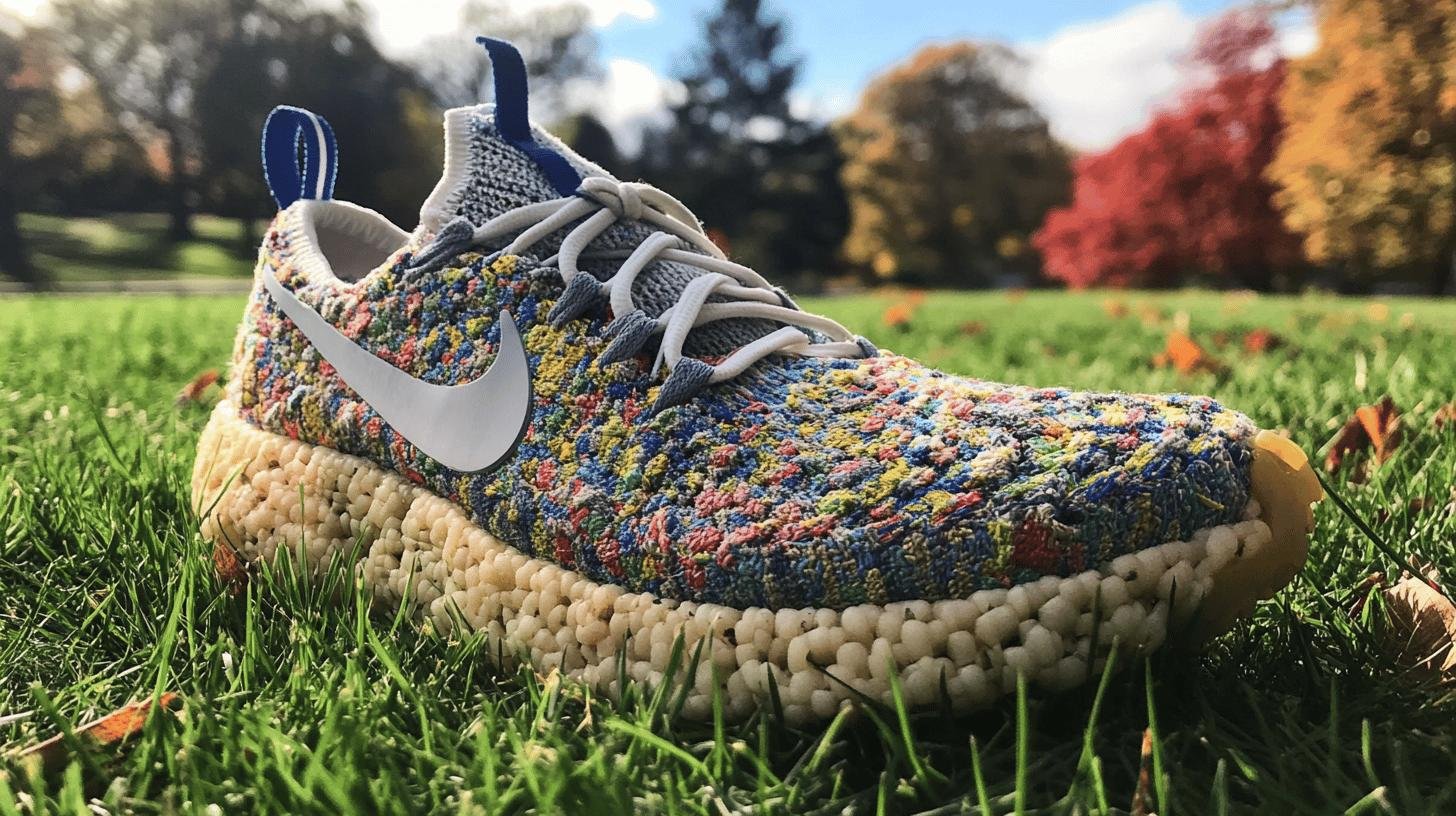TL;DR:
- Nike aims for 50% women in global corporate roles and 45% in leadership by 2025; U.S. target is 30% for racial and ethnic minorities.
- DEI initiatives include employee resource groups, inclusive hiring practices, mentorships, unconscious bias training, and leadership development.
- “Move to Zero” sustainability goal targets zero carbon and waste; aims for 100% renewable energy by 2025 and a 70% reduction in carbon emissions.
- Currently, 76% of Nike products use sustainable materials.
- Nike’s Space Hippie shoes incorporate 50% recycled materials.
- Nike emphasizes transparent reporting for accountability in DEI and sustainability.
- Challenges include navigating controversies, systematic issues, and maintaining representation targets.
Is Nike’s focus on diversity, equity, and inclusion (DEI) along with sustainability just a PR move or genuine progress? The brand has set ambitious targets, including a goal of 50% women in global corporate roles and eco-friendly initiatives like Move to Zero. However, the tension between corporate ideals and public perception is increasingly evident.
This article examines Nike’s strategies and evaluates their impact on diversity and the environment. Explore their DEI goals, sustainability efforts, and the accountability reports that support them. Are they setting a standard or merely keeping pace? Let’s find out.
Nike’s Approach to Diversity, Equity, and Inclusion (DEI)
Nike has ambitious plans to boost diversity in its workforce. By 2025, it aims for women to hold 50% of global corporate roles and 45% of leadership positions. In the U.S., Nike targets 30% leadership representation by racial and ethnic minorities. These goals are key to Nike’s mission to boost workplace equity.
To achieve this, Nike has launched several DEI initiatives, such as:
- Employee resource groups
- Inclusive hiring practices
- Mentorship opportunities for minorities
- Unconscious bias training
- Leadership development programs for diverse employees
These efforts are making a difference. For example, employee resource groups offer support networks for employees from various backgrounds. Inclusive hiring attracts a diverse talent pool, matching the diversity of Nike’s customers. Additionally, mentorship and leadership programs pave pathways for underrepresented employees to advance in their careers.
Despite progress, challenges remain. Consistent commitment and flexible strategies are vital for meeting representation objectives. Addressing unconscious biases and ensuring diverse voices in decision-making are ongoing needs. Yet, Nike’s DEI efforts exemplify a forward-thinking approach to building an inclusive workplace.
Nike’s Sustainability Goals and Progress

Nike’s “Move to Zero” aims to cut its environmental footprint to zero carbon and waste. This involves rethinking and redesigning processes across the company. A key part of this is Nike’s pledge to use 100% renewable energy by 2025, aiming to reduce facility carbon emissions by 70%. This commitment to renewable resources is part of its broader sustainability strategy.
Nike is also using more sustainable materials in its products. As of lately, 76% of Nike’s shoes and clothes contain sustainable materials. This shift underscores Nike’s dedication to design innovation, focusing on reducing non-renewable resource use and boosting material efficiency.
However, achieving these sustainability goals is not without hurdles. Challenges include maintaining progress and addressing technology and supply chain issues. Nike plans to refine its strategies continually and push the envelope in sustainable innovation.
Nike’s DEI and Sustainability Reports: Transparency and Accountability
Nike prioritizes transparent reporting to showcase its efforts in DEI and sustainability. By sharing detailed progress reports, Nike gives stakeholders valuable insights into its initiatives and achievements. This transparency helps build trust and allows others to hold Nike accountable for its goals. Regularly publishing these reports reinforces Nike’s commitment to a more inclusive and sustainable business.
Challenges remain for Nike as it strives in DEI and sustainability:
- Tackling internal systemic issues
- Navigating controversies like the Kaepernick and Felix incidents
- Consistently meeting representation and sustainability targets
- Balancing business goals with social commitments
Nike’s reports align with its broader corporate social responsibility endeavors. They emphasize accountability and engagement with social issues. By openly sharing progress and facing challenges head-on, Nike strengthens its role as a responsible corporate entity and sets a benchmark for industry peers.
The Role of Nike’s Sustainable Product Innovations

Nike’s Space Hippie shoe is a milestone in eco-friendly design. This collection stands out by using 50% recycled waste materials, reflecting Nike’s commitment to reducing its environmental footprint. By using materials that would otherwise end up as waste, Nike turns potential waste into innovative products.
Other sustainable innovations include:
- Flyleather, with at least 50% recycled leather fiber
- Nike Air soles featuring 50% recycled materials
- The “Crater Foam” midsole incorporating Nike Grind rubber
- Recycled polyester in various apparel
- Circular design emphasis with the “Reuse-A-Shoe” program
These products lower Nike’s carbon footprint and meet consumer demand for sustainable goods. As people increasingly value sustainability, Nike’s eco-friendly designs enhance brand appeal and market position. These innovations are more than waste reduction efforts—they signal Nike’s push for a circular economy. By backing reusable or recyclable products, Nike supports a sustainable product lifecycle, positioning itself as an innovator in sustainability.
Nike’s Woke-Free Ideology and Business Strategy
How does Nike balance social issues with business? By aligning DEI and sustainability with its core strategy. This balance is crucial as Nike navigates societal debates. Despite mixed reactions, Nike weaves these topics into its central business approach for authenticity and responsibility.
How does ethical consumerism affect Nike’s marketing? It pushes brands like Nike to embrace transparent, ethical strategies. By prioritizing ethics, Nike strengthens brand reputation and customer trust. This strategy underscores connecting with consumers on shared values, bolstering Nike’s market presence amid an increasingly discerning audience.
Final Words
Nike’s commitment to DEI (Diversity, Equity, and Inclusion) and sustainability outlines its goals for gender and racial representation alongside reducing carbon emissions. While the company is making strides in these areas, challenges remain, particularly regarding transparency and accountability.
Nike’s initiatives, including the Space Hippie shoe and other sustainable innovations, reflect ongoing efforts to address these issues. However, there are debates and controversies surrounding its practices, which raise questions about the authenticity of its commitments. Ultimately, while Nike’s actions in DEI and sustainability indicate a focus on social responsibility, the impact on consumers and the environment will depend on its ability to meet its stated goals and navigate ongoing scrutiny.
FAQs
What are Nike’s DEI goals for 2025?
Nike aims for 50% women in global corporate roles and 45% in leadership, with a target of 30% racial and ethnic minority representation in U.S. leadership roles.
How does Nike connect diversity and inclusion to sustainability?
By fostering an inclusive culture, Nike promotes diverse ideas that drive innovation in sustainable practices.
What are some of Nike’s key DEI initiatives?
Key initiatives include employee resource groups, inclusive hiring practices, leadership diversity goals, mentorship programs, and workplace inclusion training.
What sustainability goals is Nike pursuing?
Nike’s Move to Zero initiative aims for zero carbon and waste, with plans to use 100% renewable energy by 2025 and a commitment to sustainable materials in 76% of its products.
How does Nike’s stance on social issues impact its brand?
Nike’s social stances have garnered both praise and criticism, affecting brand perception and consumer trust, particularly as consumers increasingly value ethical practices.

